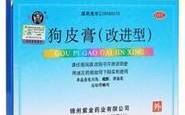Plaster medications are one of the four major traditional forms of medicine in China, alongside pills, powders, and ointments. They are favored by patients for their simplicity of use, convenience, and direct application of medicinal properties to the affected area. However, curing diseases requires not only accurate clinical diagnosis and scientific composition of medicinal ingredients but also the timing and precise dosage of medication, which are crucial for efficacy and safety. Here, I have summarized the usage times and precautions for several commonly used Chinese herbal plasters in hospitals, hoping to assist you in using external plasters correctly and avoiding adverse reactions from improper application.
1. Gou Pi Gao (Improved Dog Skin Plaster)
This Gou Pi Gao is specially labeled as “Improved” for two reasons: first, it modifies the traditional black plaster type to eliminate lead; second, it uses sub-particle adhesives, which provide better adhesion compared to traditional rubber without affecting normal human activity.
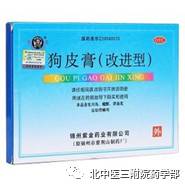
This medication dispels wind and cold, relaxes muscles, invigorates blood circulation, and alleviates pain. It is used for acute sprains, rheumatic pain, and soreness in joints and muscles. When using, clean the affected skin with warm water and dry it, take out the plaster, peel off the protective paper, leaving the adhesive tape and brown plaster, and apply it to the painful area or acupoint. Then, press it down for a few minutes to ensure full contact of the medicinal film with the skin without air pockets. When applying to joints (such as neck, wrist, elbow, waist, knee, ankle joints), it should be applied in a semi-flexed position, with the elbow and knee joints applied laterally.
The application time for one plaster should ideally be within 24 hours.
When using this Gou Pi Gao, please pay attention to:
① It contains toxic herbs such as Chuan Wu (Aconitum carmichaelii), Yang Jinhua (Datura), Bai Qu Cai (Corydalis), Bai Hua Cai Zi (Brassica), and Chan Su (Bufo), thus it is absolutely prohibited for pregnant women. Additionally, due to the presence of toxic ingredients, it must not be tasted, especially to avoid contact with infants who are still in the oral stage to prevent poisoning.
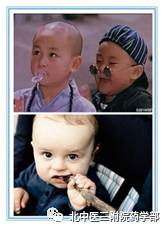
② The medication has added Diphenhydramine Hydrochloride, which enhances its anti-inflammatory effects on arthritis. However, it should be noted that high doses of Diphenhydramine have significant inhibitory effects on the central nervous system, thus this plaster should not be applied over large areas or for long periods. Furthermore, the central inhibitory effect of Diphenhydramine may cause decreased attention and slowed reactions in sensitive individuals, so drivers of vehicles, ships, and airplanes should not use this medication.

③ Oral Diphenhydramine can enter breast milk, and its central inhibitory effects can lead to respiratory difficulties in sensitive infants, potentially resulting in suffocation. For safety, it is not recommended for breastfeeding women.
④ Due to the inclusion of Hong Hua (Carthamus tinctorius), Ru Xiang (Boswellia), and Mo Yao (Commiphora), which have blood-invigorating properties, women during menstruation should use it cautiously to prevent excessive menstrual flow.
⑤ The medication contains Ma Huang (Ephedra), and the ephedrine it contains is a stimulant, thus it is prohibited for athletes.
2. She Xiang Zhuang Gu Gao (Musk Bone Strengthening Plaster)

This medication has analgesic and anti-inflammatory effects. It is used for rheumatic pain, joint pain, low back pain, neuralgia, muscle soreness, sprains, and bruises. When using, clean the surface of the affected skin, dry it, tear off the isolation layer covering the plaster, and apply the plaster surface to the affected skin. In cold weather, massage and heat application can be added.
The application time for one plaster should ideally be within 24 hours.
When using She Xiang Zhuang Gu Gao, please pay attention to:
① Musk is the main ingredient of this plaster, but musk has a strong dispersive power, which can not only invigorate blood circulation and dispel stasis but also induce labor and inhibit the implantation of fertilized eggs. Therefore, it should be strictly prohibited for women who are preparing for pregnancy or are pregnant.
② This plaster contains musk and Ma Huang, both of which are stimulants, thus it is prohibited for athletes.
③ The ingredients Chuan Wu and Cao Wu contain toxic components, thus it should only be used externally and not tasted, and should not be applied over large areas or for long periods, and must be kept away from children.
④ This plaster contains Diphenhydramine Hydrochloride, which enhances its anti-inflammatory effects on arthritis. However, it should be noted that high doses of Diphenhydramine have significant inhibitory effects on the central nervous system, thus this plaster should not be applied over large areas or for long periods. Furthermore, the central inhibitory effect of Diphenhydramine may cause decreased attention and slowed reactions in sensitive individuals, so drivers of vehicles, ships, and airplanes should not use this medication.
⑤ Oral Diphenhydramine can enter breast milk, and its central inhibitory effects can lead to respiratory difficulties in sensitive infants, potentially resulting in suffocation. For safety, it is not recommended for breastfeeding women.
⑥ If local dermatitis, rash, skin itching, localized edema, or skin ulceration occurs after application, promptly remove the plaster, stop using the medication, and consult a doctor if symptoms do not improve after stopping.
⑦ It is prohibited to use on broken skin.
3. Huoxue Zhitong Gao (Blood Invigorating Pain Relief Plaster)
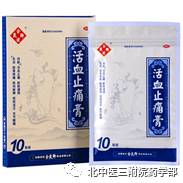
This plaster invigorates blood circulation and alleviates pain, relaxing muscles and unblocking meridians. It is used for muscle and joint pain, numbness, phlegm nodules, and joint soreness.
The application time for one plaster should ideally be within 24 hours.
This Huoxue Zhitong Gao is derived from the formula “Baozhen Gao” from the Qing Dynasty, and in the 1960s, it was modified into a rubber plaster, making it one of the earliest domestically developed rubber plasters.
When using Huoxue Zhitong Gao, please pay attention to:
① Due to the presence of ingredients such as Xi Xin (Asarum), Xiang Jia Pi (Cinnamon), Tian Nan Xing (Rhizoma Arisaematis), and Dian Qian (Atropa belladonna), which contain toxic components, it is not suitable for long-term or large-area use, and it is prohibited for pregnant women, and must be kept away from children.
② Atropa belladonna preparations usually indicate prohibition for patients with glaucoma and prostate issues. This plaster contains Atropa belladonna extract, and although it is for external use, it is recommended that patients with glaucoma or prostate diseases use it under medical guidance and not on their own.
③ Women during menstruation and breastfeeding should use it cautiously.
④ If skin allergies (notable itching), redness, or blisters occur after use, promptly remove the plaster, stop using the medication, and seek medical attention if symptoms are severe.
4. Qi Zheng Xiao Tong Tie Gao (Qi Zheng Pain Relief Plaster)

This plaster invigorates blood circulation, dispels stasis, and alleviates swelling and pain. It is used for acute and chronic sprains, bruises, bone hyperplasia, rheumatic and rheumatoid pain. It is also suitable for stiff neck, shoulder periarthritis, low back strain, and chronic pain.
The application time for one plaster should ideally be within 24 hours.
This plaster originates from Tibetan medicine, and its main feature is that it needs to be used with a wetting agent. Before applying, clean the affected skin, remove the plastic film from the plaster, and evenly apply the wetting agent from the small bag onto the surface of the medicinal pad. Only after wetting can the plaster be applied to the affected area or acupoint.
When using Xiao Tong Tie Gao, please pay attention to:
① The Tibetan herb Jijiang contains toxic components, thus it is not suitable for pregnant women. Also, due to its toxicity, it must not be tasted, especially to avoid contact with infants who are still in the oral stage to prevent poisoning.
② Patients with allergic constitutions may experience adhesive allergies or drug contact itching reactions, even redness and blisters. If any of these symptoms occur, promptly remove the plaster, stop using the medication, and consult a doctor.
③ It is not suitable to apply this plaster on open wounds.
5. Dai Wen Jiu Gao (Substitute Moxibustion Plaster)
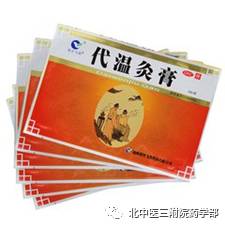
Dai Wen Jiu Gao is composed of warm and aromatic Chinese herbs, stimulating the acupoints through the warming properties of the herbs, thus serving as a substitute for moxibustion therapy, hence the name “Dai Wen Jiu Gao”. It warms the meridians, dispels cold, and alleviates pain. It is used for bi syndrome caused by wind and cold, with symptoms of cold pain in the waist, back, and joints; cold damage to the spleen and stomach causing abdominal cold pain and diarrhea; chronic rheumatic arthritis and chronic gastroenteritis with the above symptoms.
The application time for one plaster should ideally be within 4 hours, and some doctors recommend applying it for 2-4 hours in winter and 1-2 hours in summer. This is because in the hot summer months, the skin pores are wide open, and the warming medicinal properties are easily absorbed through the skin, thus the application time is halved compared to winter.
When using Dai Wen Jiu Gao, please pay attention to:
① Ensure the skin is clean and dry before application; otherwise, it may not adhere well.
② The application site should be kept dry. If bathing or contact with water is necessary, remove the plaster 30-60 minutes in advance, as exposure to water may irritate the area where the plaster was applied, causing redness and pain. However, there is no need to be overly concerned, as drying the area will alleviate the discomfort.
③ Avoid vigorous exercise after application. Vigorous exercise may induce sweating, which can irritate the plastered area similarly to exposure to water.
④ Pregnant women should avoid using it: as warm and aromatic herbs may cause fetal restlessness and consume fetal energy. Women and children with delicate skin or allergic constitutions should also avoid using it, as sensitive skin may not tolerate the warming stimulation.
⑤ If there is a significant burning sensation, itching, or localized redness and swelling at the application site, promptly remove the plaster, stop using the medication, and seek medical attention. (First-time users should pay attention to their skin’s tolerance level; mild pain, redness, and warmth are normal. However, do not endure severe pain; if burning pain occurs, promptly remove the plaster to prevent worsening skin reactions.)
⑥ The number of applications per day should follow medical advice, and generally, there should be at least a 2-hour interval between two applications on the same acupoint.
⑦ During the application period, avoid raw and cold foods, and protect against wind and cold.
6. Tian He Gu Tong Tie Gao (Tian He Bone Pain Plaster)
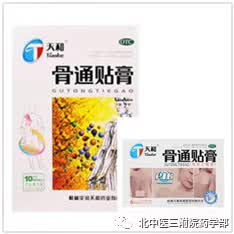
There are two types of Tian He Gu Tong Tie Gao on the market, with similar main ingredients, including Ding Gong Teng (Dichroa febrifuga), Ma Huang (Ephedra), Dang Gui (Angelica sinensis), Gan Jiang (Dried Ginger), Bai Zhi (Angelica dahurica), Hai Feng Teng (Cocculus trilobus), Ru Xiang (Boswellia), San Qi (Notoginseng), Jiang Huang (Turmeric), La Jiao (Capsicum), Zhang Nao (Camphor), Jin Bu Huan (Hypericum), and Bo He (Mentha), all produced by the same manufacturer, differing only in the adhesive used. One is traditional, while the other is a new PIB (Polyisobutylene) type. The traditional type uses rubber as the adhesive, but some people may be allergic to rubber, so they can use the new PIB type. The PIB type is less irritating to the skin compared to the traditional rubber type.
This medication dispels wind and cold, invigorates blood circulation, reduces swelling, and alleviates pain. It is used for local joint pain, swelling, numbness, and limited movement due to cold dampness and blood stasis. For external use, apply to the affected area. Before applying the plaster, ensure the affected skin is clean and dry, and ensure that the direction of the plaster’s elasticity aligns with the direction of joint movement. The application time for one plaster should ideally be within 12 hours.
When using Tian He Gu Tong Tie Gao, please pay attention to:
① If skin redness or itching occurs during use, the application time can be appropriately reduced. If redness and itching persist after reducing the time, stop using the medication and consult a doctor.
② This product should not be used long-term or over large areas. Typically, a treatment course lasts 7 days, and the interval between two courses should follow medical advice.
③ Pregnant women and those with skin allergies should use it cautiously.
④ Due to the presence of Ma Huang, which contains ephedrine, a stimulant, this product is prohibited for athletes.
7. Tong Luo Qu Tong Gao (Meridian Unblocking Pain Relief Plaster)
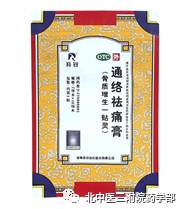
This plaster invigorates blood circulation, dispels cold and dampness, reduces swelling, and alleviates pain. It is used for osteoarthritis of the waist and knee characterized by blood stasis and cold dampness obstruction. Symptoms include sharp or dull joint pain, joint stiffness, limited movement, and cold limbs. The application time for one plaster should ideally be within 12 hours, once a day.
When using Tong Luo Qu Tong Gao, please pay attention to:
① Pregnant women and children should use it cautiously, and keep the plaster away from children.
② It is prohibited to use on broken skin.
③ If skin rashes, redness, or itching occur after use, indicating an allergy to the plaster, promptly remove it, stop using the medication, and seek medical attention if symptoms are severe.
8. Fu Fang Nan Xing Zhi Tong Gao (Compound Nan Xing Pain Relief Plaster)
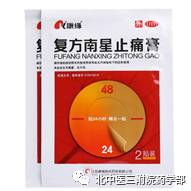
This Compound Nan Xing Pain Relief Plaster dispels cold and dampness, invigorates blood circulation, and alleviates pain. It is used for joint pain, swelling, and limited movement caused by cold dampness and blood stasis, which worsens in cold conditions. This plaster has a prominent reminder on the packaging indicating that the application time for one plaster is 24 hours, and it emphasizes that the interval between two plasters should be one day.
When using this plaster, please pay attention to:
① The ingredients Tian Nan Xing (Rhizoma Arisaematis), Chuan Wu (Aconitum carmichaelii), and Xi Xin (Asarum) all contain toxic components, thus it is absolutely prohibited for pregnant women and must be kept away from children.
② Due to the presence of toxic components, it should not be used long-term or over large areas to prevent overdose and poisoning.
③ If skin allergies (notable itching), redness, or blisters occur after use, promptly remove the plaster, stop using the medication, and seek medical attention if symptoms are severe.
④ It is prohibited for those with skin diseases and on broken skin.
⑤ Those with bleeding tendencies and women during menstruation should use it cautiously, as the blood-invigorating components may increase menstrual flow.
⑥ During the application period, avoid raw and cold foods, and greasy foods.
9. Qian Shan Huoxue Gao (Qian Shan Blood Invigorating Plaster)
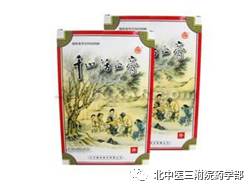
This Qian Shan Huoxue Gao invigorates blood circulation, dispels stasis, relaxes muscles, reduces swelling, and alleviates pain. It is used for swelling and pain in the skin and joints, limited movement, as well as for bruises and osteoarthritis of the waist and knee. Qian Shan Huoxue Gao is one of the more traditional black plasters in TCM. The main characteristics of black plasters are threefold: first, they usually have a longer application duration; second, they contain lead powder (specifically, lead(II) oxide); third, they must be preheated before use. The application time is 24-48 hours.
When using this plaster, please pay attention:
① Before application, this plaster needs to be heated to soften it, which can be done in three ways:
-
Using a hairdryer to heat and soften;
-
Using an alcohol lamp or stove to heat and soften;
-
Placing the sealed plaster bag in hot water to heat and soften.
② Before applying the plaster, clean and dry the painful area with a warm towel, then apply the plaster to the painful area and related acupoints, smoothing and pressing it down. In cold weather, after applying the plaster, you can use a hot water bag to apply heat to enhance the treatment effect.
③ If skin rashes, blisters, or severe itching occur after use, indicating an allergy to this plaster, promptly remove it and stop using the medication, and seek medical attention if symptoms are severe.
④ Due to the blood-invigorating properties of Qian Shan Huoxue Gao, it is prohibited for pregnant women and should be used cautiously by women during menstruation.
⑤ This product contains lead powder (specifically, lead(II) oxide), and children should not use it excessively, as it may lead to hyperactivity.
⑥ It is prohibited to use on broken skin.
⑦ Black plasters may leave residue when removed; methods to easily remove plaster residue include:
-
Using Zheng Gu Shui, Hong Hua Oil, Flower Dew Water, Feng You Jing, or Turpentine to wipe off;
-
Using edible alkali to remove plaster stains from clothing.

